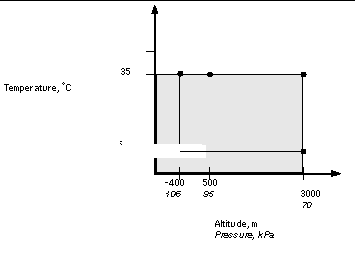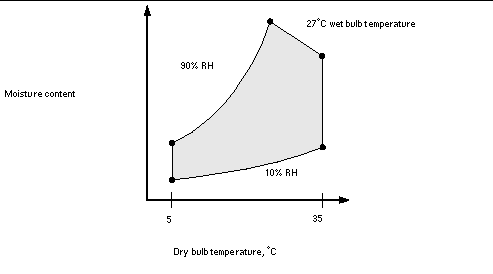| C H A P T E R 2 |
|
Site Preparation |
This section contains information about the following system site requirements for the Sun Fire B1600 blade system chassis:
This section provides the general environmental parameters and airflow requirements for the Sun Fire B1600 blade system chassis.
|
Note - The Sun Fire B1600 blade system chassis uses front-to-back forced air cooling. |
You can operate and store the system safely in the conditions detailed in TABLE 2-1, FIGURE 2-1 and FIGURE 2-2.
|
5°C to 35°C
|
||


Your environmental control system must provide intake air for the server which complies with the limits specified in General Environmental Parameters.
To avoid overheating, do not direct warmed air:
The operating environmental limits in TABLE 2-1 reflect what the systems have been tested to, in order to meet all functional requirements. Operating computer equipment in extremes of temperature or humidity increases the failure rate of hardware components. To minimize the chance of component failure, use the server within the optimal temperature and humidity ranges.
An ambient temperature range of 21°C to 23°C is optimal for system reliability. At 22°C it is easy to maintain safe relative humidity levels. Operating in this temperature range provides a buffer in the event of the environmental support systems failing.
Ambient relative humidity levels between 45% and 50% are the most suitable for data processing operations in order to:
Electrostatic discharge (ESD) is easily generated and less easily dissipated in areas where the relative humidity is below 35%, and becomes critical when levels drop below 30%.
The Sun Fire B1600 blade system chassis has been designed to function in a natural convection airflow when mounted in a rack or cabinet and uses front-to-back forced air cooling. To meet the declared environmental specification follow these guidelines:
To estimate the heat generated by a Sun Fire B1600 blade system chassis convert the figure for the system's power consumption from watts to BTU/hr.
The formula to convert from watts to BTU/hr is to multiply the power in watts by 3.415. For example:
total power consumption of blades + total power consumption of SSCs + total power consumption of PSUs x 3.415 = xxxxx BTU/hr
For power consumption figures for the SSC, the PSU and blades, see Estimating Power Consumption
|
Note - Do not install multiple Sun Fire B1600 blade system chassis in a four-post rack or cabinet unless your cooling system is capable of dissipating in excess of the total thermal load. |
|
Maximum operating current [1] |
|
|
Maximum power supply rating [2] |
|
|
Maximum in-rush current[3] |
|
|
This value will depend on the estimated heat dissipation. See Estimating the Heat Dissipation for more information. |
To estimate the total power consumption for one or more Sun Fire B1600 blade system chassis installed in a single rack or cabinet, add together the individual power requirement figures for each system chassis you have installed, using the values in TABLE 2-3. A minimum system configuration would be:
One blade + one SSC + two PSUs
Copyright © 2004, Sun Microsystems, Inc. All rights reserved.